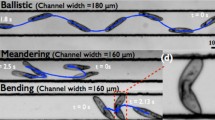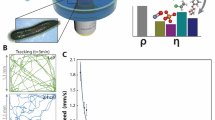Abstract
In-depth quantitative visualization studies are required to understand the flow induced by swimming micro-organisms and find potential applications. The present study visualized the flow induced by Tetrahymena pyriformis of size 45–50 μm, which swam freely and via stimulation by galvanotaxis in a PDMS micro-chamber using a micro-particle image velocimetry system. The results showed that the maximum velocity of the induced flow was around 430 μm/s for free swimming and 700 μm/s for galvanotactic-controlled swimming. Due to the applied electric field, the electro-osmosis flow led to increased velocity of roughly 135 μm/s at 3 V/mm. The increased velocity stems from the increased motility of the cell under the electric field. Therefore, it was demonstrated that galvanotaxis can control the swimming direction and increase the induced velocity.
Graphical Abstract












Similar content being viewed by others
References
Blake J (1971a) Infinite models for ciliary propulsion. J. Fluid Mech 49(02):209–222
Blake J (1971b) A spherical envelope approach to ciliary propulsion. J. Fluid Mech 46(01):199–208
Blake J (1972) A model for the micro-structure in ciliated organisms. J. Fluid Mech 55(01):1–23
Brennen C (1974) An oscillating-boundary-layer theory for ciliary propulsion. J. Fluid Mech 65(04):799–824
Brennen C, Winet H (1977) Fluid mechanics of propulsion by cilia and flagella. Annu Rev Fluid Mech 9(1):339–398
Chou H, Spence C, Scherer A, Quake S (1998) Microfabricated devices for sizing DNA and sorting cells Citeseer. Proc SPIE 3258:181–187
Doh I, Cho Y (2005) A continuous cell separation chip using hydrodynamic dielectrophoresis (DEP) process. Sens Actuator A Phys 121(1):59–65
Doku G, Verboom W, Reinhoudt D, Van Den Berg A (2005) On-microchip multiphase chemistry—a review of microreactor design principles and reagent contacting modes. Tetrahedron 61(11):2733–2742
Eckert R, Naitoh Y (1970) Passive electrical properties of Paramecium and problems of ciliary coordination. J Gen Physiol 55(4):467–483
Eckert R, Naitoh Y (1972) Bioelectric control of locomotion in the ciliates. J Eukaryot Microbiol 19(2):237–243
Ho C, Lin R, Chang H, Liu C (2005) Micromachined electrochemical T-switches for cell sorting applications. Lab Chip 5(11):1248–1258
Kim M, Breuer K (2007) Use of bacterial carpets to enhance mixing in microfluidic systems. J Fluid Eng 129:319
Kim DH, Cheang UK, Hidai KL, Byun D, Kim MJ (2010a) Artificial magnetotactic motion control of Tetrahymena pyriformis using ferromagnetic nanoparticles: a tool for fabrication of microbiorobots. Appl Phys Lett 97(17):173702–173704
Kim S, Lee E, Lee H, Lee S, Lee S, Kim T (2010b) Microfabricated ratchet structures for concentrating and patterning motile bacterial cells. J Micromech Microeng 20:095006–095011
Logan B, Dettmer J (1990) Increased mass transfer to microorganisms with fluid motion. Biotechnol Bioeng 35(11):1135–1144
Luo R, Lin C (2008) A review of mechatronics and bio-inspired mechatronics system. J Biomechatron Eng 1(1):1–36
Machemer H (1974) Frequency and directional responses of cilia to membrane potential changes in Paramecium. J Comp Physiol A 92(3):293–316
Naitoh Y, Kaneko H (1972) Reactivated Triton-extracted models of Paramecium: modification of ciliary movement by calcium ions. Science 176(4034):523–524
Naitoh Y (1974) Bioelectric basis of behavior in protozoa. Integr Comp Biol 14(3):883–893
Pedley T, Kessler J (1992) Hydrodynamic phenomena in suspensions of swimming microorganisms. Annu Rev Fluid Mech 24(1):313–358
Steager E, Kim C, Patel J, Bith S, Naik C, Reber L, Kim M (2009) Control of microfabricated structures powered by flagellated bacteria using phototaxis. Appl Phys Lett 90(26):263901–263903
Tibayrenc M (1996) Towards a unified evolutionary genetics of microorganisms. Annu Rev Microbiol 50(1):401–429
Yang S, Hsiung S, Hung Y, Chang C, Liao T, Lee G (2006) A cell counting/sorting system incorporated with a microfabricated flow cytometer chip. Meas Sci Technol 17:2001–2009
Acknowledgments
This research was supported by the Konkuk University in 2010.
Author information
Authors and Affiliations
Corresponding author
Rights and permissions
About this article
Cite this article
Kim, J., Jang, Y., Byun, D. et al. Quantitative measurement of dynamic flow induced by Tetrahymena pyriformis (T. pyriformis) using micro-particle image velocimetry. J Vis 14, 361–370 (2011). https://doi.org/10.1007/s12650-011-0102-1
Received:
Revised:
Accepted:
Published:
Issue Date:
DOI: https://doi.org/10.1007/s12650-011-0102-1




